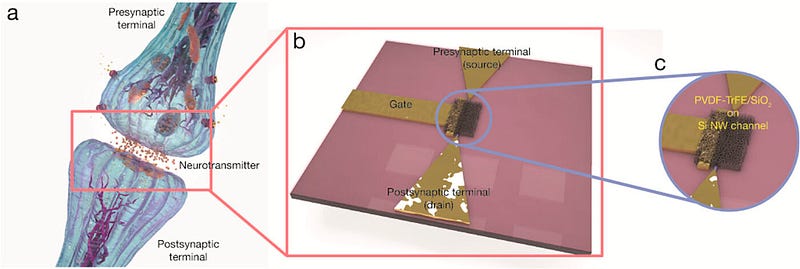Innovative Neuromorphic Electronics: Mimicking Brain Efficiency
Written on
Understanding Neuromorphic Electronics
Recent advancements in neuromorphic electronics highlight their potential to emulate the efficiency of the human brain. Korean researchers have successfully created a transistor that functions similarly to a synapse 85.1% of the time.

The brain operates through a complex network of neurons, with around one hundred billion neurons communicating through approximately one quadrillion synapses. This intricate system allows for high-performance, low-energy information processing. However, to replicate such efficiency, modern electronic components must overcome several significant challenges, including the need for reliable synthesis processes, stability, and the ability to faithfully imitate the electrochemical behavior of biological synapses.
The Role of Synaptic Transistors
A synaptic transistor must effectively replicate the biological phenomenon known as spike-timing-dependent plasticity. This means the system should be capable of adjusting its operational parameters based on its historical performance, akin to how biological synapses adapt their activity according to past experiences.
This adaptability is closely tied to learning processes, where a synapse can experience plastic changes—either potentiation, which enhances its activity, or depression, which diminishes its efficiency. These mechanisms can be viewed as analogous to learning and forgetting, respectively.
Recent Breakthroughs in Synaptic Transistors
In an unprecedented collaborative study, Korean scientists have developed and showcased a prototype of a synaptic transistor. This innovative device merges the dependability of silicon nanowires with the synaptic plasticity of ferroelectric polymers, resulting in what is termed a ferroelectric field transistor (FeFET).
When subjected to a series of electric pulses that simulate neuronal firing, the FeFET demonstrated both potentiation and depression, key characteristics of neuromorphic systems. Furthermore, a computer model utilizing artificial neural networks and trained on actual synaptic data revealed that this device was capable of recognizing handwritten digits with an accuracy of 85.1%.
The prototype's compatibility with inverter circuits—where it generates the inverse logic level of its input—was also tested. In this configuration, the FeFET achieved a noise margin of 41.6% while consuming a mere 0.6 µW per logic gate.
As noted by the researchers, “This indicates that the FeFET synapse transistor could serve as a fundamental component for low-power logic device applications.”
The first video titled "Sandamirskaya Yulia - Neuromorphic Computing: From Theory to Applications" delves into the practical implications and theoretical background of neuromorphic computing, showcasing its potential applications.
The second video, "Why Brain-like Computers Are Hard," explores the challenges faced in developing brain-like computing systems, highlighting the complexities involved in mimicking neural processes.
© Gianina Buda, PhD 2021